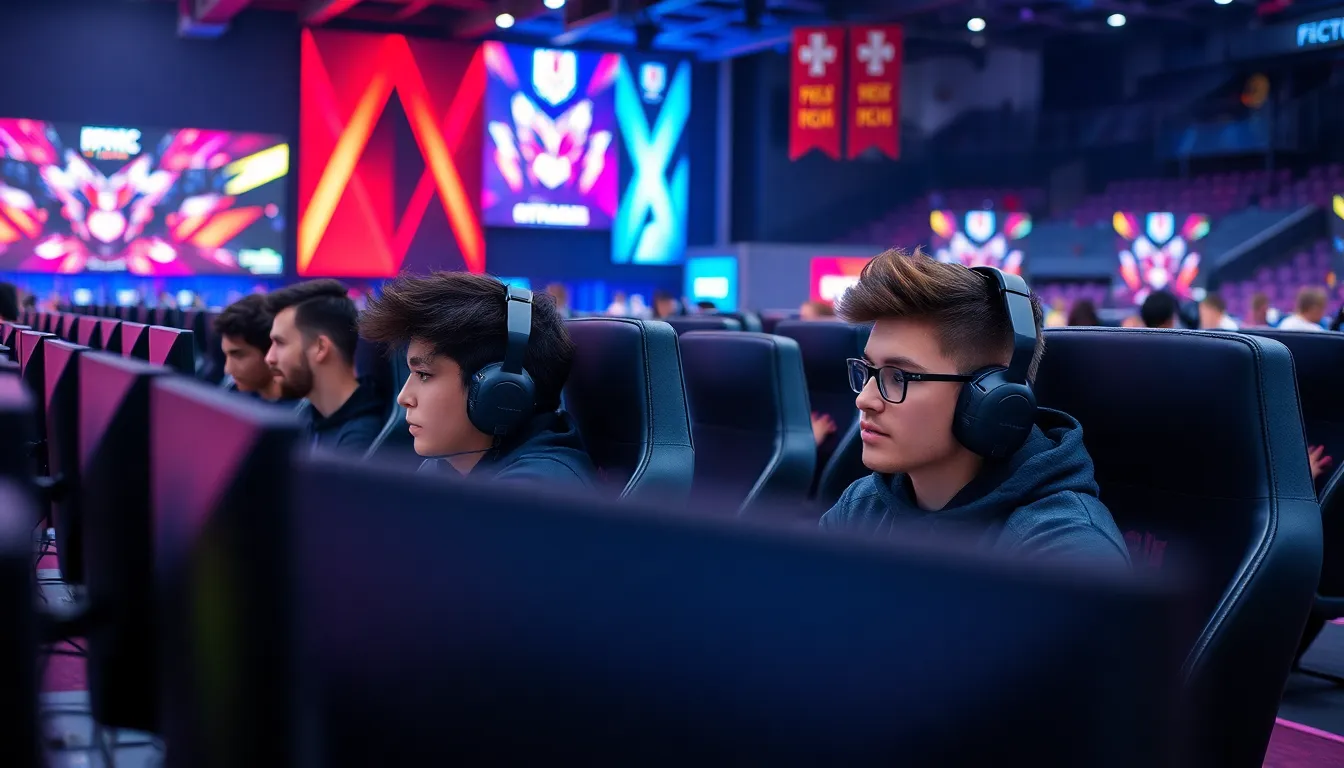In the fast-paced world of esports, every gamer dreams of glory, fame, and maybe a sponsorship deal that pays for their avocado toast addiction. But how does one rise to the top of the leaderboard? Enter global esports rankings—your ticket to understanding who’s dominating the virtual arenas and who’s just a keyboard warrior in their mom’s basement.
Table of Contents
ToggleOverview of Global Esports Rankings
Global esports rankings serve as essential benchmarks for evaluating player and team performance across various games. These rankings incorporate multiple factors, including tournament results, match statistics, and historical performance data. Recognizing top performers in the esports arena requires thorough analysis and accurate data collection, contributing to an evolving competitive landscape.
Ranking systems differ among organizations, impacting how players and teams earn their positions. For instance, ESL and HLTV boast well-respected methodologies, often cited for their credibility. Each ranking system may emphasize different criteria such as win rates, match significance, or opponent strength, leading to variances in rankings.
Consensus around global rankings helps fans engage with the esports community actively. Fans often monitor updates to rankings to understand shifts in the competitive scene. Rankings influence not only fan interest but also team sponsorship opportunities, reflecting players’ and teams’ performances.
Furthermore, the rise of esports has led to an increase in metrics utilized for ranking purposes. Advanced analytics, like player efficiency ratings and in-game performance indicators, contribute to more accurate assessments. Websites dedicated to esports provide rich data but excitement stems from live competition results.
Overall, global esports rankings encapsulate the achievements of talented individuals and teams. Detailed analysis facilitates accurate reflections of current standings, keeping stakeholders informed and engaged. Through ongoing updates and adjustments, these rankings capture the dynamic nature of the esports industry effectively.
Factors Influencing Global Esports Rankings

Multiple factors contribute to the formation of global esports rankings. Understanding these dynamics assists fans and analysts in grasping the competitive landscape.
Player Performance Metrics
Player performance metrics serve as critical determinants of rank. Statistics such as kill-to-death ratios and win rates reflect an individual’s in-game effectiveness. Additionally, match statistics, including average damage per round and objective completions, provide deeper insights into performance. These metrics often come from professional matches and tournaments. Players’ consistency over time influences their overall ranking, with historical data highlighting their progression. Analyzing individual performances across different games adds further depth to the evaluation process.
Team Success and Achievements
Team success and achievements play a vital role in global rankings. Winning prestigious tournaments boosts a team’s position substantially. Different organizations, like ESL and BLAST, affect rankings based on tournament outcomes. Championship titles and tournament placements indicate a team’s capability and strategy implementation. Collaborations with skilled players also enhance team profiles, showcasing synergy and cohesion. Teams that consistently perform well against top-tier opponents gain higher visibility and credibility. Overall, collective accomplishments shape the perception and ranking of teams within the esports community.
Major Organizations and Their Rankings
Various organizations shape the global esports landscape by ranking teams and players. Each entity employs its own unique criteria.
Riot Games
Riot Games oversees games like League of Legends and Valorant. The ranking system relies heavily on competitive performance within official tournaments. Their annual League of Legends World Championship significantly impacts team standings. Players earn ranking points based on match outcomes and overall tournament placements. Consistently high placements in these events elevate a team’s visibility in the rankings. Notably, teams that perform well in the Mid-Season Invitational also see jumps in their global rankings. Collaborative play and strategic teamwork enhance player effectiveness, reinforcing Riot’s commitment to fostering competitive integrity.
Valve Corporation
Valve Corporation governs the competitive scenes of Dota 2 and Counter-Strike: Global Offensive. Their ranking system assesses team performance through tournament results and match statistics. Valve hosts major events such as The International, which decisively influences team rankings. Success in these tournaments results in higher placement on leaderboards. Statistics like kill-death ratios and objective controls serve as crucial metrics in evaluating players. Teams showcasing consistent performance against top rivals solidify their standings. Valve emphasizes transparency, ensuring rankings reflect true competitive dynamics across its games.
The Impact of Global Esports Rankings
Global esports rankings significantly shape the competitive environment for players and teams. These rankings influence how audiences perceive top performers, ensuring that excitement surrounds major events. Established brands depend on rankings to identify sponsorship opportunities, as higher-ranked teams often attract more financial support.
Players strive for recognition within these rankings, driving them to enhance their skills and teamwork. Engagement rises when fans track their favorite teams’ standings, creating a vibrant community around the esports scene. Enthusiasts often follow ranking changes closely, leading to increased discussions on social media platforms.
Tournament results play a key role in ranking shifts. Teams performing well in prestigious events often see marked improvements in their standings. Competitive integrity remains vital, with organizations like Riot Games and Valve Corporation promoting transparency in their ranking systems.
Performance metrics offer insights into individual and team effectiveness. Kill-to-death ratios and win rates serve as critical indicators of a player’s impact during matches. Achievements in competitions bolster a team’s reputation, further solidifying their positions in the global hierarchy.
Advanced analytics enhance ranking accuracy. Websites dedicated to esports provide detailed data, enabling fans and analysts to evaluate performance comprehensively. This rich analysis empowers stakeholders to make informed decisions regarding player acquisitions and sponsorships.
The interplay between rankings and the esports ecosystem continues to evolve, reflecting the dynamics of the industry. Observing these changes offers valuable insights into emerging trends and shifts in player popularity. Global esports rankings not only highlight exceptional talent but also foster a competitive spirit, inspiring both existing and aspiring players.
Trends in Global Esports Rankings
Shifts in competitive dynamics frequently influence global esports rankings. Emerging games often disrupt established hierarchies, with titles like Valorant and Apex Legends gaining traction. New teams frequently enter the scene, challenging established players and altering the rankings landscape.
The growing importance of content creation also reshapes rankings. Content creators who engage audiences can significantly boost a team’s visibility. A strong online presence often correlates with higher sponsorship opportunities.
Patterns in player transfers affect team standings. As skilled players move between teams, changes in rankings quickly follow. These transfers create anticipation among fans who closely monitor potential impacts on competitive performance.
Furthermore, data analytics enhance the accuracy of rankings. Organizations utilize advanced metrics to evaluate player performance more thoroughly. This shift toward data-driven assessments helps teams and players understand their strengths and weaknesses.
Fan engagement remains a pivotal aspect of esports rankings. Dedicated followers actively track their favorite teams and players, driving conversations around performance. Increased fan interaction often influences sponsorship decisions, with brands aiming to capitalize on popular trends in the community.
Lastly, the rise of regional competitions impacts global rankings. Various regions host tournaments that contribute to the overall ranking systems. These events not only showcase local talent but also highlight the competitive diversity within the esports landscape.
Global esports rankings play a vital role in shaping the competitive landscape of gaming. They not only highlight the achievements of top players and teams but also serve as benchmarks for aspiring competitors. As the esports industry continues to evolve, these rankings will adapt to reflect new dynamics and emerging games.
The impact of these rankings extends beyond performance metrics. They influence fan engagement and sponsorship opportunities, driving teams to elevate their game. With the integration of advanced analytics and the rise of regional competitions, the future of global esports rankings promises to be even more dynamic and inclusive.
Ultimately, these rankings are more than just numbers; they represent the dedication and passion of players striving for excellence in the ever-changing world of esports.



